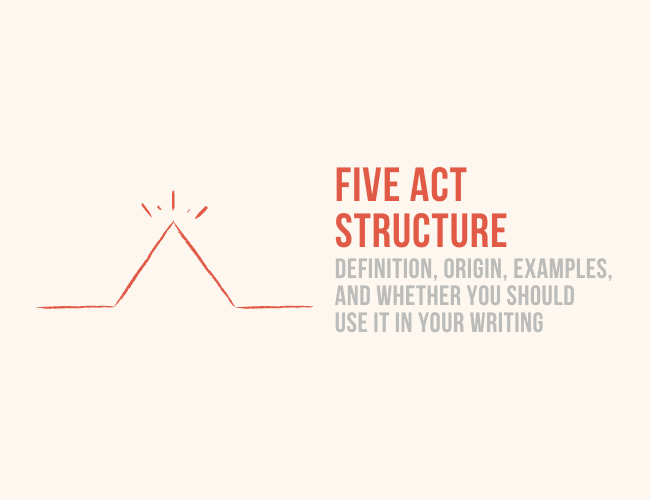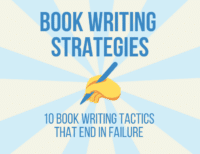Five act structure is a method of structuring a story that has existed for centuries. But does it work? And more importantly, will it work for your story?

In this article, we will learn the definition of the five act structure, explore its origins, look at popular examples, and talk about whether it’s actually useful as a narrative structure framework for readers and writers.
What Is the 5 Act Structure: 5 Act Structure Definition
Five act structure is a formal plot structure that divides a story into five parts, called acts. These are usually the introduction or exposition, rising movement, climax, falling action, and catastrophe or resolution.
Origins of the 5 Act Structure, and Dramatic Structure in General
Many people talk about Aristotle and his treatise Poetics as the originator of the five act dramatic structure, but anyone who says that hasn’t read Poetics (you can, though, right here). It mentions that there should be a beginning, middle, and end to a story, but says little more about dramatic structure (and even less that makes sense for modern storytelling). That’s okay. Aristotle was a smart person, but that doesn’t have to mean he perfectly understood story's basic structure.
Some claim that Shakespeare was the inventor of the five act dramatic structure. But while Shakespearean dramas have five acts, the act and scene breaks were written in after the fact, in 1709 by Shakespeare’s first editor, not by Shakespeare himself.
It was likely the Roman playwright Horace who first advocated for five act plays. In his essay on drama, Ars Poetic, written in 19 BC, he said, “Let a play which would be inquired after, and though seen, represented anew, be neither shorter nor longer than the fifth act.” Though in the same paragraph he advocates using deus ex machina and a cast of no more than three members (which was standard in his time), so I’m not sure he’s a good literary role model.
The biggest promoter of the five act structure in modern history though, is a German playwright and author from the mid-1800s named Gustav Freytag, the originator of Freytag’s Pyramid.
Freytag’s Pyramid is now by far the most widely taught story structure frameworks in the world. It’s also one of the least understood. If you read Freytag, you can see that his understanding of story structure looks very different from how people teach it today.
You can read our full exploration of Freytag’s Pyramid here.
But what are Freytag's five acts and what purpose does each serve?
The Elements of 5 Act Structure
According to Freytag and his proponents, each of the five acts has a purpose, which I will list below.
Note that here I am chiefly discussing how Freytag intended the five acts to work, not how modern teachers of story have reinterpreted the five act structure.
Act 1: Introduction
The introduction contains two key elements: the setup for the story, which includes the exposition, and the “exciting force,” the equivalent to the inciting incident.
As you might expect, the purpose of the exposition is to introduce the audience to the story’s world and characters, deliver any pertinent backstory, and set up all of the elements of the plot that will be triggered throughout the story.
However, the introduction also sets up the exciting force, which Freytag also calls the “complication.” This is when some force of will on the part of the protagonist or an outside complication forces the protagonist into motion.
In other words, the introduction both sets up the story as a whole and also gets it moving.
Length of Act 1
Act one contains about ten percent of the story, according to Freytag.
Act 2: Rising Movement (not the Rising Action)
First, please note that while many interpreters call this the “rising action,” Freytag himself called act two the rising movement.
The purpose of the second act is to continue the movement of the story toward its climax. The rising movement doesn’t contain the climax but sets it up.This means the character arc is beginning to move as they make choices that result in emotional impact (and character development).
Most of all, the scenes in the rising movement must be interesting, both deepening the complications of the story and enlarging the plot.
In addition, all characters must be introduced by the end of the act, according to Freytag.
Length of Act 2
Act two tends to be the longest act by far, containing approximately thirty-five to forty-five percent of the content of the story.
Act 3: Climax
In Freytag’s framework, the climax occurs in the middle of the story, or at the most, just past the middle.
Fretyag thinks of the climax less as the moment of greatest drama, but instead as a reflection point. If things have gone well for the protagonist, at the climax they start to fall apart tragically.
Or in a comedy, if things have been going poorly for the protagonist, things start improving.
Play and Counter-Play
Freytag thinks of well-constructed stories as two equal parts. He calls the first half the play and the second half the counter-play, with the climax as the point where they turn.
He was also almost solely interested in tragedy, spending very little time analyzing stories with happy endings, and it seems as though this hyperfocus on tragedy influenced his thinking about the shapes of story, because Freytag’s Pyramid bears a direct correlation to the Icarus story arc.
The climax is also, according to Freytag, the scene or group of scenes in which the fullest energy of the protagonist is portrayed, whether for good or ill, pathos or pride.
After the climax, whatever ambition the protagonist showed is reversed against himself, and whatever suffering she endured is redeemed. In other words, the energy, values, and themes shown in the first half are reversed and undone in the second half.
As he puts it, “This middle, the climax of the play, is the most important place of the structure; the action rises to this; the action falls away from this.”
We’ll discuss whether that same level of importance bears out in practice later on.
Length of Act 3
The climax, in terms of length, is one of the shortest acts in this framework, especially because it is usually just made up of one scene.
Act 4: Falling Action
The falling action contains all of the scenes between the climax and the final act, the catastrophe.
In the falling action, we assume, everything that was going well for the protagonist starts to go badly, in the case of a tragedy. Or in the case of a comedy, everything that was going badly starts to go well.
This is the counter-play, and it's meant to mirror the events of the play.
Freytag himself gave very little information about the falling action, failing even to include a section on it (unlike every other act), so it seems as if this is the section of your story he thinks will come easiest (although anyone who has written a novel, film, or tv show can tell you the last half of the middle can be some of the hardest writing).
However, there was one section of the falling action that Freytag was very interested in: the force of the final suspense.
The force of the final suspense, occurring just before the catastrophe in act five, is meant to give the audience a final moment of doubt in the final outcome.
Freytag, explaining the importance of the force of the final suspense, says, “It is well understood that the catastrophe must not come entirely as a surprise to the audience.”
This is a moment of suspense where a slim possibility of reversal is hinted at, but ultimately never delivered. It may be the point where the villain looks like they’re going to get away, or the couple looks like they might stay broken up, or the noble thieves look as if they’re going to get caught by the authorities. However, it’s just an act.
Length of Act 4
Act four, like act two, the rising movement, contains a large amount of the story, around twenty-five to thirty percent of the story. It is necessarily shorter than act two, since Freytag thought of his pyramid as slightly right-leaning, but it is still longer than any other section of the story other than the second act.
Act 5: Catastrophe
In act five, we have the final pay off of the plot, where all the things that have been building finally occur all at once.
It is the scene, in a tragedy, where everyone dies. Or in a comedy, it is the big wedding. Or in an action story, the final battle scene.
As we’ve said, Freytag was chiefly focused on tragedy, and the name for act five reflects that. It’s also referred to as the resolution, or fittingly, the denouement—which literally means, tying loose ends—though Freytag did not use these terms.
Length of Act 5
Act five tends to be the shortest acts, often containing just two or three scenes, sometimes even just one. It will usually be less than ten percent of a story.
Five Act Structure Example: Romeo and Juliet
To better understand how the five act structure works, I’ve created an annotated version of Romeo and Juliet.
In this document, you’ll be able to click through the table of contents, exploring each act, and seeing where it ends and where the next act begins. You’ll also be able to spot the exciting force and the force of the final suspense.
Explore Romeo and Juliet annotated with the five act structure here »
Then, below, we will talk more about how this five act structure example works.
One thing to note at the start is that the five act structure does not match the act labels present in the play. These were added after publication for the sake of easier reading, in 1709, by Shakespeare’s first editor, Nicholas Rowe.
Act one contains the first two scenes of the play, one of which is the exciting incident. The exciting incident, according to Freytag, is when Romeo agrees to go to the Capulet’s ball with Benvolio and his other friends to see if he can spot Rosaline, the woman whom he is pining over and who has rejected him. Of course, he ends up not seeing Rosalyn, instead falling in love at first sight with Juliet.
Act two, by far the longest act, essentially contains Romeo and Juliet’s entire romance, from their first meeting at the Capulet’s ball to their garden scene, their marriage, and even the fight with Tybalt and his eventual death.
This act covers a lot of ground, enough that you begin to wonder what the point of breaking up the story into five acts is if one of those acts contains nearly half of the story!
Act three in this example, the climax, on the other hand, is quite short. It begins immediately after Tybalt’s death, as Romeo is mourning his cousin-by-marriage, and ends upon his final goodbye to Juliet.
You might rightly wonder how Freytag chose this scene as the climax, since it doesn’t feel very climactic. For Freytag, the climax is less the most climactic moment and more the turning point and beginning of the counter-play. Up until this moment, everything has been going well for the young couple. Now, things will reverse.
Act four, the falling action, contains most of the second half of the play, including Romeo’s exile, Juliet and Friar Lawrence’s plan to escape her marriage to Paris by faking her death, Romeo’s discovery of her “death” and purchase of his own life-ending elixir, and then Romeo’s approach to the Capulet’s tomb, where Juliet’s body lies. The last scene of act four is Romeo’s fight with Paris, who is mourning for his fiancée and decides to confront Romeo.
Act five is only two scenes long, containing Romeo’s discovery of Juliet, his suicide, Juliet’s waking to discover Romeo dying, and then her suicide. The final scene is the discovery of the lovers first by Friar Lawrence, then the two warring families, and finally their reconciliation in the company of the Prince.
Problems With the 5 Act Structure Based on This Example
The problem with Freytag’s reading of Romeo and Juliet, and the five act structure in general, is that no modern reader would call Romeo saying goodbye to Juliet the climax of the story.
Maybe you could say the fight with and killing of Tybalt was climactic, but the couple’s parting? I’ve studied story structure for more than a decade from theorists like Robert McKee, Shawn Coyne, Blake Snyder, Joseph Cambell, and more, and not one of them would call that scene the climax. They might call it the turning point or the “dark night in the soul” or the midpoint, but not the climax.
In fact, nearly all of them would consider the penultimate scene, the dual-suicide of the young couple—what Freytag calls the catastrophe—to be the climax. Why? Because it’s the most climactic scene! It’s the moment of greatest stakes, highest contrast of love vs. hate, life vs. death.
In addition to the climax, most modern story structure frameworks wouldn’t consider Romeo deciding to go to the Capulet’s ball the exciting force, or inciting incident.
Instead, the inciting incident would be the young couple’s “meet cute,” the first moment they see each other and erupt into desire.
So if you have two of the main building blocks wrong, does your entire story structure fall apart? And how does five act structure compare to three act structure?
Let’s tackle both of those questions, starting with the latter.
3 Act Structure vs. 5 Act Structure
What’s the difference between three act structure and five act structure? Is one better than the other?
Three Act Structure
Three act structure is a story structure framework that divides a story into three separate pieces. Originally postulated by Aristotle, who wrote that stories should have a “beginning, a middle, and an end,” this framework was established in the late 19th and 20th centuries.
The simplest way to think about the three act structure is the following century-old writing advice:
In the first act, put your character up a tree. In the second act, throw rocks at them. By the third act, bring them down.
Like the five act structure, each act has a purpose:
- Act 1: Setup. The setup introduces the characters, the world of the story, and kicks off the action with the inciting incident.
- Act 2: Build. In the build, narrative tension increases; a subplot often begins; the protagonist experiences obstacles, success, and at least one major failure; and they reach some kind of breaking point.
- Act 3:Payoff. Tension rises to a peak as the protagonist confronts their failure and makes a final attempt at solving their problem, leading to the climax, succeeding or failing based on the story type. The story ends with a moment of resolution.
This structure contains all the same pieces as the five act structure, notably the inciting incident and climax, but does so in a simplified, less arbitrary way. It also fits better with other plot structures, including the Hero’s Journey.
Comparing Act Lengths
In the five act structure, the length of each act feels random and uneven:
Five Act Structure Approximate Act Length
- Act 1: 10 percent
- Act 2: 45 percent
- Act 3: 5 percent
- Act 4: 35 percent
- Act 5: 5 percent
Weird, right? In the three act structure, it’s much simpler:
Three Act Structure Approximate Act Length
- Act 1: 25 percent
- Act 2: 50 percent
- Act 3: 25 percent
All of these are estimates, changing from story to story, but most stories that work wind up in these approximate boundaries. Better, right?
Moreover, three act structure is flexible. Five act structure was designed specifically to describe V-shaped tragedies (and sometimes comedies, although Freytag wasn’t very interested in those).
But stories come in many different shapes. See our narrative arc guide for the top six plot diagrams.
The three act structure is flexible enough to work for any story shape, from Hollywood blockbusters to literary novels and even to short stories, not just one specific story arc, like Freytag was focused on.
You can even layer three act stories, creating nine act structures that give you even more flexibility.
Does 5 Act Structure Work, And How Should YOU Structure Your Story?
The big question that I began this post with was this, does the five act structure really work? Does it make sense for readers as a way to understand story? And especially for writers and screenwriters, will it work as a framework to write your own novels and screenplays?
After studying Freytag’s Art of the Technique, and also reading dozens of articles and books about Freytag’s Pyramid and the five act structure, I have a verdict.
No, five act structure doesn’t work, at least as Freytag originally intended it. It’s a broken model that starts by mislabeling the inciting incident, continues to sow confusion by calling the turning point the climax, includes a mostly irrelevant section called the falling action (which barely exists in most stories, and which Freytag himself doesn’t bother to define), and ends by misunderstanding where the real climax is in a story.
However, since Freytag’s Technique was published in the 1800s, his ideas have been completely re-interpreted and largely misunderstood. That being said, in some ways, they’re misunderstood for the better! Freytag’s pyramid has morphed from a straight pyramid shape to something of a reverse checkmark.
All of this is progress: but it’s progress based on a broken foundation, and a misunderstood foundation on top of that.
All of that’s to say, there are much better story structure frameworks out there, including Story Grid and our in-house framework, The Write Structure.
Stop wasting your time trying to understand the five act structure. Instead, go use one of them.
What do you think? Do you find the five act structure or three act structure more helpful for your writing and screenwriting? Let us know in the comments.
PRACTICE
While we don’t recommend using the five-act structure, as plot points they’re still useful. So let’s put Freytag’s plot points to use with a creative writing exercise.
First write a story in five sentences using the following plot points:
Introduction or exposition:
Rising movement:
Climax:
Falling action:
Catastrophe or resolution:
Once you’ve outlined your five-sentence story, choose one of the five plot points and write a scene within it.
Take fifteen minutes to plot your story and draft a scene. When you’re done, share your story in the Pro Practice Workshop, and be sure to leave feedback for your fellow writers!







0 Comments